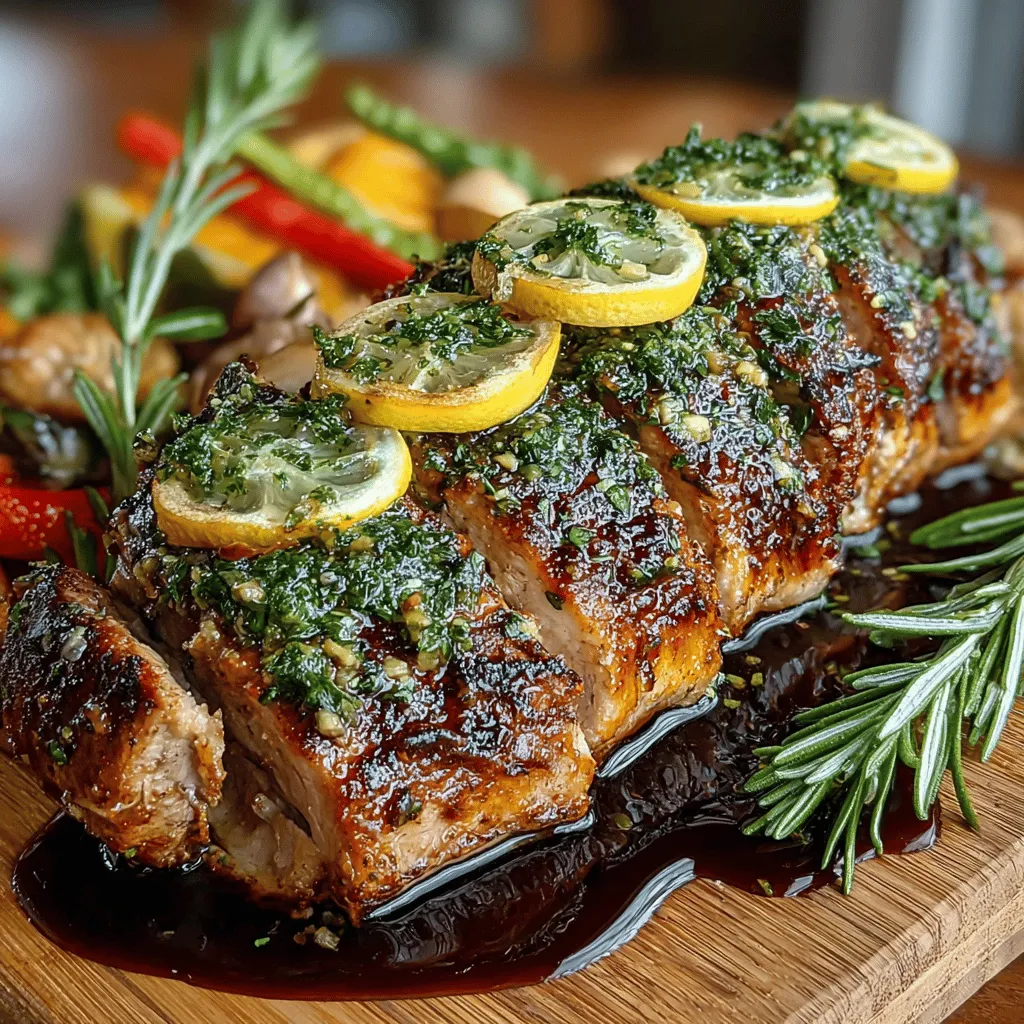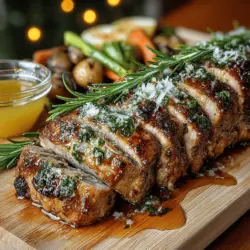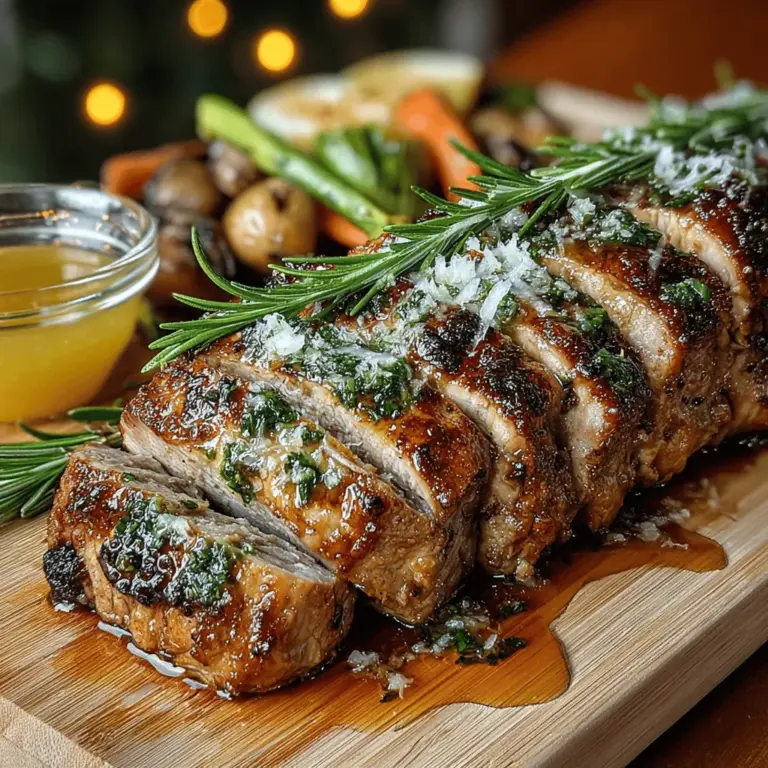Garlic Herb Roasted Pork Tenderloin: A Flavorful Culinary Delight
Garlic Herb Roasted Pork Tenderloin is a dish that perfectly marries the rich, succulent flavors of pork with the aromatic freshness of herbs and garlic. This recipe stands out not just for its taste but also for its simplicity, making it an ideal choice for both novice cooks and seasoned chefs. With its tender texture and robust flavor, pork tenderloin has earned its place in numerous culinary traditions around the globe, often gracing tables for family dinners or special events.
In many cultures, pork tenderloin is considered a versatile ingredient that can be prepared in various ways—from roasting to grilling. Its adaptability allows it to shine in a multitude of cuisines, and when paired with the right ingredients, such as garlic and fresh herbs, it transforms into an unforgettable meal. Cooking with herbs and garlic not only enhances the flavor profile of the dish but also brings numerous health benefits. Garlic, known for its anti-inflammatory and immune-boosting properties, complements the lean protein of pork tenderloin beautifully. The addition of fresh herbs like rosemary and thyme adds depth and complexity, making this dish a favorite for those who appreciate a burst of flavor in every bite.
Furthermore, Garlic Herb Roasted Pork Tenderloin is a crowd-pleaser, making it suitable for a variety of occasions. Whether you’re hosting a casual family gathering, preparing a romantic dinner for two, or planning a festive celebration, this dish fits the bill. Its elegant presentation and delightful aroma can elevate any meal into a memorable experience.
Understanding Pork Tenderloin
Pork tenderloin is a specific cut of meat that comes from the muscle that runs alongside the backbone of the pig. This cut is known for its tenderness and mild flavor, making it a popular choice among meat lovers. Unlike other cuts of pork that may require careful cooking to avoid toughness, pork tenderloin is naturally lean, and when cooked properly, it remains juicy and flavorful.
One of the significant nutritional benefits of pork tenderloin is its high protein content coupled with low fat. A typical serving can provide a substantial amount of protein while keeping calorie counts in check, making it a healthy option for those looking to maintain a balanced diet. Additionally, pork tenderloin is a great source of essential vitamins and minerals, including B vitamins, zinc, and selenium, contributing to overall health and well-being.
For home cooking, pork tenderloin presents an excellent option due to its quick cooking time and minimal preparation requirements. It absorbs flavors well, making it an ideal canvas for various marinades and seasonings. This versatility allows home cooks to experiment with different flavor combinations, ensuring that every meal can be unique and exciting.
Ingredients Breakdown
To create a memorable Garlic Herb Roasted Pork Tenderloin, it is essential to select high-quality ingredients that will enhance the dish’s overall flavor. The primary ingredients include:
– Pork Tenderloin: The star of the dish, this cut should be fresh and well-trimmed. Look for a tenderloin that is pink in color with minimal marbling, as this indicates a quality piece of meat.
– Garlic: Fresh garlic is crucial for infusing the pork with its pungent aroma and flavor. When roasted, garlic mellows and sweetens, creating a perfect balance with the savory notes of the pork.
– Fresh Herbs (Rosemary and Thyme): These herbs are essential for elevating the flavor profile of the dish. Rosemary adds a distinct pine-like flavor, while thyme contributes earthy notes that enhance the overall taste. Fresh herbs provide a vibrant touch that dried herbs simply cannot replicate.
– Lemon Juice: The acidity of lemon juice brightens the dish and helps to tenderize the meat. It also adds a refreshing contrast to the richness of the pork, making each bite more enjoyable.
– Chicken Broth or White Wine: Both options serve as a flavorful base for the marinade. Chicken broth adds a savory depth, while white wine can introduce a slight sweetness and complexity. The choice between the two depends on personal preference and the desired flavor outcome.
Each ingredient plays a vital role in this dish, contributing not only to the taste but also to the overall experience of Garlic Herb Roasted Pork Tenderloin.
Preparation Steps
Preparation is key to ensuring that the flavors of the Garlic Herb Roasted Pork Tenderloin meld beautifully. The marination process is particularly important for infusing the pork with the aromatic qualities of garlic and herbs. Begin by preparing the marinade, which consists of minced garlic, chopped rosemary, thyme, lemon juice, and either chicken broth or white wine.
To start, mince several cloves of fresh garlic, ensuring that you achieve a fine consistency to maximize flavor distribution. Next, finely chop the fresh rosemary and thyme, releasing their essential oils and enhancing their aromatic qualities. Combine these ingredients in a bowl along with the lemon juice and your choice of broth or wine.
Once the marinade is ready, place the pork tenderloin in a resealable plastic bag or a shallow dish. Pour the marinade over the pork, ensuring that it is well-coated. For optimal flavor infusion, allow the tenderloin to marinate in the refrigerator for at least one hour, although overnight is preferable if time permits. This resting period allows the meat to absorb the flavors of the garlic and herbs, resulting in a more flavorful and succulent dish.
After marinating, remove the pork tenderloin from the refrigerator and allow it to come to room temperature for about 30 minutes before cooking. This step helps to ensure even cooking throughout the meat. Preheat your oven to the appropriate temperature, and prepare for the final cooking steps that will transform this marinated tenderloin into a mouthwatering centerpiece for your next meal.
With these initial steps in place, you are well on your way to creating a delicious Garlic Herb Roasted Pork Tenderloin that will impress your family and friends alike. The combination of tender pork, aromatic herbs, and savory garlic is sure to make this dish a standout at any gathering.

Cooking a pork tenderloin can seem daunting, but with the right techniques and tips, you can create a flavorful and tender dish that will impress your family and friends. Let’s delve into the importance of using a sharp knife, the searing process, and the roasting technique, followed by serving suggestions, health considerations, and a conclusion that emphasizes the versatility of this dish.
Importance of Using a Sharp Knife
When preparing your pork tenderloin, a sharp knife is crucial for slitting the meat effectively. A dull knife can tear the meat fibers, leading to a less appealing texture and uneven cooking. By using a sharp knife, you can create clean, even slits along the tenderloin, allowing for better marinating and seasoning absorption. This technique enhances the flavor profile of your dish, ensuring that every bite is packed with the delicious garlic and herb blend you’ve chosen.
Searing the Pork Tenderloin
Searing your pork tenderloin is a vital step that cannot be overlooked. This method involves cooking the meat quickly at a high temperature, which creates a caramelized crust on the outside that locks in moisture. The Maillard reaction, which occurs during searing, enhances the flavor and adds depth to your dish.
To achieve the perfect sear, heat a tablespoon of olive oil in a skillet over medium-high heat. Once the oil is shimmering, place the tenderloin in the pan, allowing it to sear for about 2-3 minutes on each side until a golden-brown crust forms. This process not only improves the texture of the meat but also adds a savory aroma that will tantalize your senses.
Cooking Techniques
Overview of the Roasting Technique
Roasting is the preferred cooking method for pork tenderloin as it allows for even cooking while maintaining moisture. After searing, transfer the tenderloin to a preheated oven set at 400°F (204°C). This high temperature will cook the meat quickly, helping to retain its juiciness. The result is a tender, succulent pork that can easily be sliced and served.
Importance of Internal Temperature
Understanding the internal temperature of your pork is essential for food safety and ensuring the best flavor and texture. The USDA recommends cooking pork to an internal temperature of 145°F (63°C) followed by a three-minute rest period. This temperature guarantees that the meat is safe to eat while remaining juicy and tender. Use a meat thermometer to check the temperature in the thickest part of the tenderloin to ensure accuracy.
The Significance of Resting the Meat
Once your pork tenderloin has reached the desired internal temperature, it’s crucial to let it rest for at least 5-10 minutes before slicing. Resting allows the juices to redistribute throughout the meat, resulting in a more flavorful and moist final product. If you cut into the tenderloin too soon, you risk losing all those delicious juices, leading to a dry and less appealing dish.
Serving Suggestions
Side Dishes
Pair your garlic herb roasted pork tenderloin with a variety of side dishes that complement its flavors and enhance your meal. Some excellent options include:
– Roasted Vegetables: Seasonal vegetables like carrots, Brussels sprouts, or sweet potatoes tossed in olive oil and herbs make for a vibrant and nutritious side.
– Salads: A fresh garden salad or a warm spinach salad with a light vinaigrette can provide a refreshing contrast to the richness of the pork.
– Grains: Quinoa, farro, or wild rice works beautifully as a hearty side, soaking up the juices from the tenderloin.
Presentation Tips
For an elegant presentation, consider slicing the tenderloin into medallions and arranging them on a platter. Drizzle some of the pan juices or a homemade herb sauce over the top for an added touch of flavor and visual appeal. Garnish with fresh herbs like parsley or thyme to add a pop of color and freshness to your dish.
Wine and Beverage Pairings
When it comes to pairing beverages with your garlic herb roasted pork tenderloin, opt for wines that enhance the dish’s flavors. A medium-bodied red wine such as Pinot Noir or Merlot complements the savory notes of the pork, while a crisp white wine like Sauvignon Blanc or Chardonnay works well with the garlic and herb elements. For a non-alcoholic option, try a sparkling water with lemon or a refreshing iced tea.
Health Considerations
Portion Control and Serving Sizes
When serving pork tenderloin, it’s essential to practice portion control. Generally, a serving size for pork is about 3-4 ounces, which is roughly the size of a deck of cards. This ensures that you enjoy the meal without overindulging.
Benefits of Fresh Ingredients
Choosing fresh ingredients over pre-packaged options not only enhances the flavor of your dish but also contributes to better nutrition. Fresh herbs, vegetables, and quality cuts of meat are packed with vitamins, minerals, and antioxidants, making your meal not only delicious but also nutritious. Additionally, fresh ingredients typically contain fewer preservatives and additives, supporting a healthier lifestyle.
Dietary Considerations
Garlic herb roasted pork tenderloin is a versatile dish that can accommodate various dietary needs. It is naturally gluten-free and low-carb, making it suitable for those following specific dietary restrictions. You can easily modify the recipe by using alternative herbs or spices to cater to your preferences while maintaining the delicious essence of the dish.
Conclusion
In summary, garlic herb roasted pork tenderloin is an impressive yet easy dish to prepare at home. The key steps, from using a sharp knife to slice the tenderloin and searing it for maximum flavor, to roasting it to the perfect internal temperature and allowing it to rest, are essential for achieving the best results.
This dish’s versatility allows it to shine in various settings, whether you’re hosting a dinner party, preparing a family meal, or simply wanting to enjoy a delightful homemade dish. The accompanying side dishes, presentation tips, and beverage pairings enhance the dining experience, making it a well-rounded meal.
We encourage you to try this recipe, embrace the cooking process, and enjoy the delightful flavors of garlic herb roasted pork tenderloin. With practice, you’ll find that cooking at home can be both rewarding and delicious!

